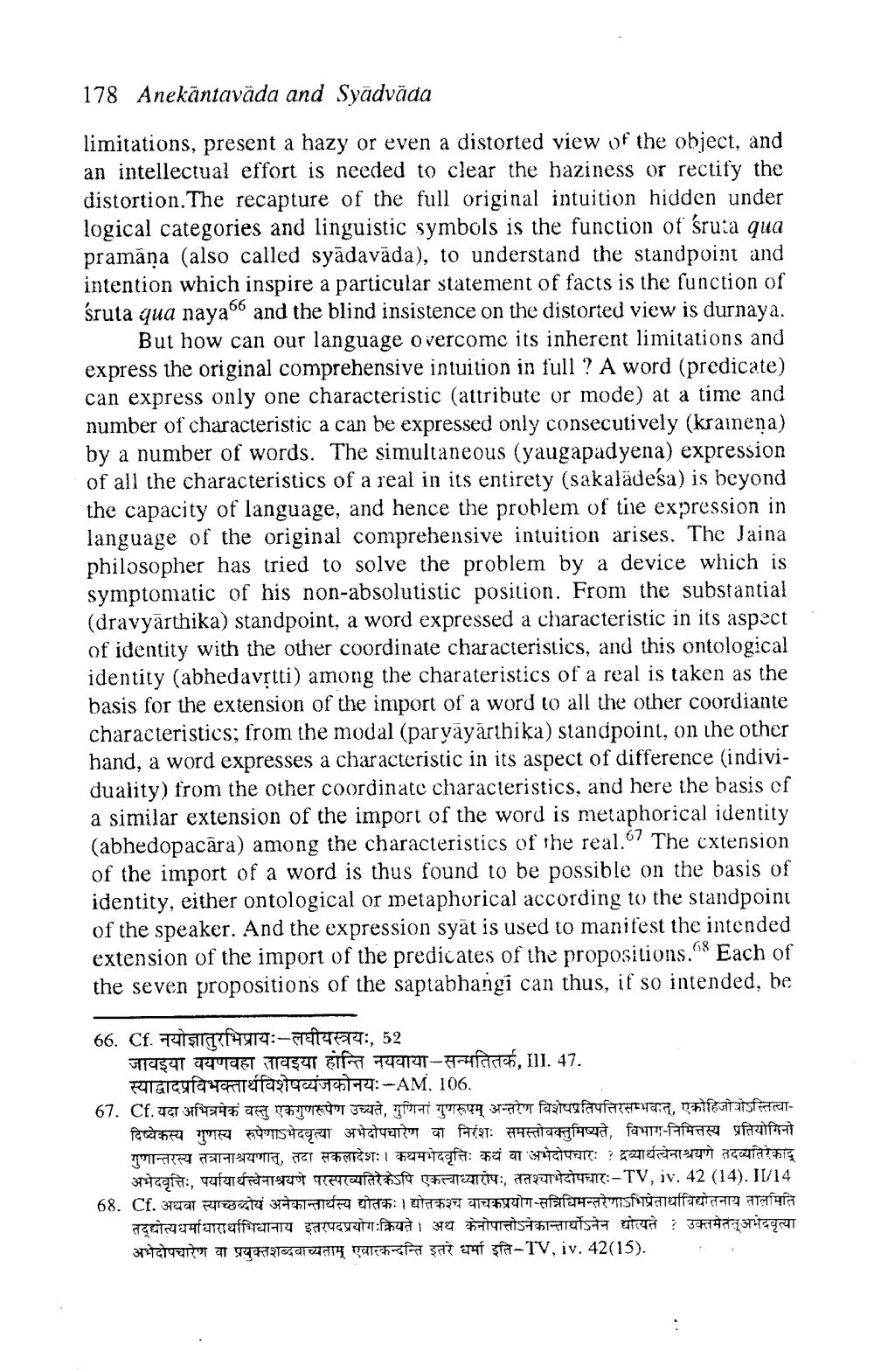________________
178 Anekantavāda and Syüdväda
limitations, present a hazy or even a distorted view of the object, and an intellectual effort is needed to clear the haziness or rectify the distortion. The recapture of the full original intuition hidden under logical categories and linguistic symbols is the function of sruta qua pramāņa (also called syādavāda), to understand the standpoint and intention which inspire a particular statement of facts is the function of śruta qua naya and the blind insistence on the distorted view is durnaya.
But how can our language overcome its inherent limitations and express the original comprehensive intuition in full ? A word (predicate) can express only one characteristic (attribute or mode) at a time and number of characteristic a can be expressed only consecutively (krainena) by a number of words. The simultaneous (yaugapadyena) expression of all the characteristics of a real in its entirety (sakalādesa) is beyond the capacity of language, and hence the problem of the expression in language of the original comprehensive intuition arises. The Jaina philosopher has tried to solve the problem by a device which is symptomatic of his non-absolutistic position. From the substantial (dravyarthika) standpoint, a word expressed a characteristic in its aspect of identity with the other coordinate characteristics, and this ontological identity (abhedavịtti) among the charateristics of a real is taken as the basis for the extension of the import of a word to all the other coordiante characteristics; from the modal (paryayarthika) standpoint, on the other hand, a word expresses a characteristic in its aspect of difference (individuality) from the other coordinate characteristics, and here the basis of a similar extension of the import of the word is metaphorical identity (abhedopacara) among the characteristics of the real.67 The extension of the import of a word is thus found to be possible on the basis of identity, either ontological or metaphorical according to the standpoint of the speaker. And the expression syat is used to manifest the intended extension of the import of the predicates of the propositions. Each of the seven propositions of the saptabhangi can thus, if so intended, be
66. Cf. telefyr9:- :, 52
JPTIST ATTEET TESZT ETT TUOTT-Hoft, III. 47.
RITGTCUTTUiteffagtartette: -AM, 106. 67. Cf. यदा अभिनमेकं वस्तु एकगुणरूपेण उच्यते, गुणिनां गुणरूपम् अन्तरेण विशेषप्रतिपत्तिरसम्भवात, एकोहिजोयोऽस्तित्वा
दिष्वेकस्य गुणस्य रूपेणाऽभेदवृत्या अभेदोपचारेण वा निरंशः समस्तोवक्तुमिष्यते, विभाग-निमित्तस्य प्रतियोगिनो गुणान्तरस्य तत्रानाश्रयणात्, तदा सकलादेशः। कथमभेदवृत्तिः कथं वा अभेदोपचारः ? द्रव्यार्थत्वेनाश्रयणे तदव्यतिरेकाद
31UTCSfe, cufarefretierunt Peters FTTT, TTTT931:-TV, iv. 42 (14). IV/14 68. Cf. अथवा त्याच्छब्दोयं अनेकान्तार्थस्य द्योतकः। द्योतकश्च वाचकप्रयोग-सन्निधिमन्तरेणाऽभिप्रेतार्धाविद्योतनाय तालमिति
तयोत्यधर्माधारार्थाभिधानाय इतरपदप्रयोगःक्रियते। अथ केनोपात्तोऽनेकान्तार्थोऽनेन द्योत्यते ? उक्तमेतत् अभेदवृत्या OntTM AT F ETIT Tattoo Tatsaf sa-TV, iv. 42(15).




